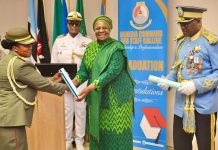Africa-Press – Namibia. Loide Jason
Kaviveterue Virere
Victoria Immanuel
President Netumbo Nandi-Ndaitwah has ordered that no resources be spared to save Etosha National Park after massive fires destroyed parts of the country’s top tourist attraction. She said Etosha is the lifeblood of Namibia’s tourism and must be protected at all costs.
Speaking through Prime Minister Elijah Ngurare in Parliament on Wednesday, the president declared the protection of Etosha National Park and its surrounding communities a top national priority, while highlighting both the urgency and unity required to confront the crisis.
“ Etosha National Park is one of those life-threatening blood arteries to our tourism industry. We can’t afford to see it going up in flames. No resources should be spared to save such blood Arteries,” said the president.
She continued. “Disasters strike when they are least expected, but it is in these moments that Namibians show resilience and solidarity”.
She praised firefighters, defence forces, ministry officials, farmers, and community members who risked their lives in the battle against the flames.
Wildfires began on 22 September 2025 inside Etosha before spreading into the Omusati and Oshana regions. A second fire erupted on 24 September, further threatening grazing land, rural livelihoods, and biodiversity.
Damage
In a follow-up press briefing, Environment Minister Indileni Daniel revealed the staggering scale of the disaster. She said nearly 854,000 hectares — representing 38% of Etosha were burned.
“To date, one elephant, six springboks, and three duikers have been confirmed dead,” the Minister said, adding that veterinarians had been deployed to care for surviving wildlife.
The minister also noted that while Etosha suffered major damage, the park was never closed to visitors.
“It remains fully open to tourists. We only issued advisories urging caution,” he said, countering speculation of a shutdown.
According to Daniel, the fire is believed to have started from charcoal production activities on a farm bordering the park’s south-western section. Strong winds and dry vegetation allowed it to spread rapidly.
Government has promised to strengthen the country’s fire management systems, including faster response times and improved coordination.
Both the president and the minister commended the collective effort of communities, private sector partners, NGOs, and government agencies.
“Your dedication and solidarity reflect the true spirit of unity and resilience that defines us as a nation,” Daniel said.
Response
The president confirmed that 311 members of the Namibian Defence Force (NDF) and 150 officials from the Ministry of Environment, Forestry and Tourism (MEFT) were deployed inside the park.
Additional NDF teams were sent to surrounding regions, supported by trucks, a water bowser, helicopters, and a mobile clinic. Three operational bases were quickly established to coordinate efforts.
By the time of her statement, all major fire fronts inside and outside the park had been extinguished, though hotspots were still monitored in villages such as Ombonde, Onoolongo, and Onambadje.
The President further explained that outside the park, another 136 NDF soldiers had been deployed in Omusati and Oshana regions, supported by MEFT officials and community volunteers. although monitoring continued
At Omutambogwomawe, 60 soldiers from the Army School of Artillery were placed in charge of nearby villages such as Uutsathima and Onamatanga. A second base was created at Amarika, manned by 35 personnel covering central areas like Okeeholongo and Onambandje. The third base was set up at Onoolongo, where 25 Air Force members were deployed, with 70 more soldiers kept on standby at Oshakati to provide backup.
The President also confirmed that the operation was well resourced, with trucks, armoured vehicles, a 15,000-litre water bowser, and helicopters for aerial support. Medical teams, including a mobile clinic, were on site to assist exhausted firefighters.
She said resources were mobilised from across Government, including the Office of the Prime Minister, various ministries, regional councils, and even the farming community around Etosha, showing a united national response.
Technique
According to Deputy Executive Director Colgar Sikopo, who spoke during the press conference yesterday, fire is a yearly natural management technique in Etosha that is utilised to control grazing and promote the growth of new vegetation. But this year’s fire, which destroyed 38% of the park, was much bigger than the typical 5–20% range.
“The fire came just before the rains. With new grass growth, the burned areas may actually attract wildlife and sustain tourism,” he said. He cautioned, however, that further fires must be prevented during the remainder of the fire season.
Timoteus Muteti, the environmental commissioner, described efforts to restrict the charcoal business and connected the fire’s cause to its manufacture. Although safety has improved because to rules and training with the Charcoal Association, he noted there are still enforcement gaps. He stated, “We have seen progress, but to prevent incidents like this, stronger sanctions and tighter controls are needed.”
Muteti also called for a balance between environmental preservation and economic progress, confirming an increase in applications for the manufacturing of charcoal.
Loses
Farmers in Omusati region are fuming after a raging wildfire killed livestock and destroyed cattle posts and grazing land.
The fire, which broke out in Etosha a week ago, rapidly spread to nearby areas due to strong winds before reaching Omusati.
One of the hardest-hit farmers, Nowa Elago, said the destruction has left him hopeless.
“I am very disappointed and not even in the mood of explaining. I lost 17 sheep in the fire, and three cattle posts are burned down completely. I am left with nothing,” Elago stressed.
Another farmer, Iingo Shikale from Otamanzi said he lost four sheep and four goats, although the exact number remains uncertain.
“I don’t know if they are burned down or roaming around in the desert. There is a high chance I will not get them,” he said.
He added that grazing shortages will worsen the plight of their surviving livestock.
“The livestock will suffer after this because there is no grass left for them,” Shikale explained.
Another victim of the fire Japhet Heimo recalled past frustrations with compensation.
“If they must compensate us, the Ministry of Environment should consider the real prices. I remember last time when my cattle were eaten by hyenas, they only paid me N$600, which is not even enough to buy another cow,” he said.
Otamanzi constituency councillor, Johannes Iiyambo, confirmed that his office has recorded all affected farmers.
“We have recorded those that lost their livestock. We are just waiting for the Ministry of Environment to come back to us with a response on the way forward,” he said.
For More News And Analysis About Namibia Follow Africa-Press






